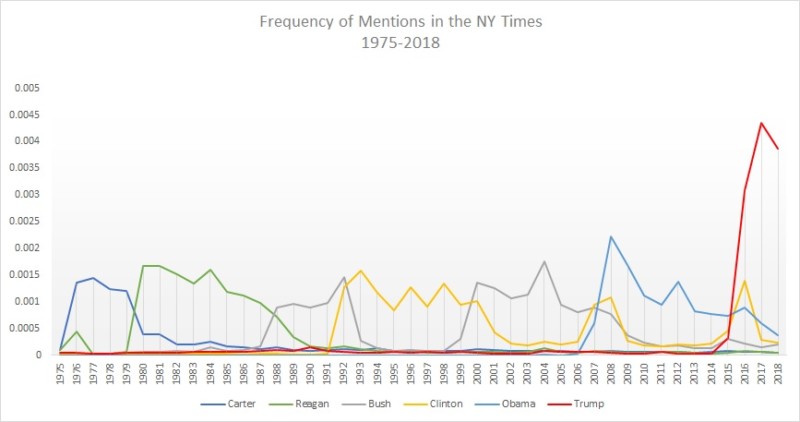Sign up for the daily CJR newsletter.
The way the press covers Donald Trump is unlike any other president in modern American history. Quantifiably so.
Communications scholar David Rozado (and two of his students, Mohammed Dinnunhan and Raymond Hua) developed a data-visualization tool to analyze coverage trends in the New York Times. I graphed all mentions of the terms “Carter,” “Reagan,” “Bush,” “Clinton,” “Obama,” and “Trump” from 1975 through 2018. As depicted below, the difference between Trump and his predecessors is stark:
The underlying data is interesting in its own regard. First, there is count: the total number of times the term appears during that year. For instance, the count for “Trump” in 2018 was 93,292.
Next, there is frequency: the result of dividing the count for a word in any given year by the total number of words that year (excluding non-substantive terms such as “and,” “but,” “the,” etc.). The frequency stat allows us to control for the fact that the total number of articles and words published can vary substantially across time. For instance, the Times published far fewer articles in 1970 than it does today. For this reason, the graph above relies on each word’s frequency rather than the count.
ICYMI: The NYT tech columnist ‘unplugged’ from the internet. Except he didn’t.
In 2017, Trump’s frequency was roughly .004. That means he was directly mentioned every 250 substantive words or so—or, given the typical length of a Times piece, two or three times per article. This average encompasses all articles from across the paper—including the sports, style, food and travel sections. It suggests little is published without some reference to Trump. He is the lens through which many other stories are filtered.
Finally, there is rank: how often a given word is used relative to other words in the corpus for that year. For instance, the rank for “Trump” in 2018 is four, indicating that his name is the fourth most-used word in the entire corpus for that year (excluding non-substantive terms).
For contrast, Obama, in his peak year of 2008, was ranked nine in the lexicon, mentioned 62,440 times. His mentions dropped off dramatically thereafter. In 2009, he slid down to 22, mentioned 47,968 times; by the next year, he was ranked 40, with 33,585 mentions. Two years after his election, the Times talks about Trump almost three times as much as they did Obama at the same point in his term.
Indeed, even indirect mentions are way up for Trump as compared to previous commanders-in-chief. For instance, consider the terms “president” (i.e. “the president says…”), “white house” (i.e. “according to the White House…”) and “administration” (i.e. “this administration has…”): The New York Times used “White House” and “president” more in 2017 than any other time since 1974 (the year of Nixon’s resignation, more than 40 years ago). For “administration” you’d have to go back to the Reagan era for a period where the term was more than it has been under Trump.
I analyzed coverage in the New York Times in large part because the tool was designed to examine this specific paper. But I would be surprised if these coverage patterns were wildly out of line with those of other publications. This is in part because flagship publications like the Times play a significant role in setting the agenda for other outlets.
Hindsight and 2020
Using these graphs, we can also gain important insights into the 2016 presidential election. During the last presidential election year, “Clinton” was ranked 24 in the lexicon, mentioned about 34,000 times. Meanwhile, “Trump” was the sixth-ranked word, mentioned nearly 77,000 times. In other words, the race was clearly “about” Trump; he was mentioned more than twice as much as his competitor.
In fairness to the press, this owes in part to Clinton, who sought to make the election a referendum on her opponent. According to a study by the Wesleyan Media Project, she ran one of the least substantial advertising campaigns in modern political history. Clinton also often tried to minimize media access; her engagements with the press were sporadic and tightly-regulated. Trump, on the other hand, would talk to anyone, anywhere, anytime about any topic—and practically anything could come out of his mouth.
The 2020 race is shaping up to be more of the same. Although there was a slight drop-off in mentions in 2018, he still remains above his 2016 levels of coverage. No other previous president comes close—nor are any of Trump’s rivals anywhere near him in terms of mentions.
ICYMI: A NYT article about Twitter got lot of pushback from journalists
Members of the press need to rethink their instinct to write endless Trump stories. That doesn’t mean a more aggressive posture; the alignment between the press and Trump’s ‘resistance’ has been part of the problem: In terms of endorsements and direct financial support, reporters and media organizations rallied behind Clinton’s candidacy (and against Trump’s) in a manner that was unlike any other contemporary election cycle.
Studies by Pew and the Harvard Kennedy School show that, even after the election, press coverage has remained critical. Even if journalists might argue that his record doesn’t allow for more positive stories, this non-stop negative coverage has not lowered supporters’ esteem for the president.
Instead, it seems to be contributing to greater polarization around the media itself. According to a recent poll by the Columbia Journalism Review, Americans have less confidence in the press today than any other major social institution—including Congress and the White House. Scaling back the obsession with Trump would almost certainly help restore some of that trust.
A Question of Priorities
The Times faces a dilemma.
There was a record spike in subscriptions over the course of the 2016 election cycle, due largely (in the Times’ own accounting) to the mutual antagonism between Trump and the paper. The publication now boasts a record high number of paid subscribers consuming Trump-laden content.
They are not alone. Many outlets have seen sharp increases in readership and subscribers by capitalizing on (and reinforcing) the obsession with Trump. Granted, they are increasingly preaching to a choir of committed partisans–and this limits their ability to actually sway minds and impact the course of events–but that may matter less to many of these companies than their bottom lines.
Consequently, there may not be much institutional will to do anything about what amounts to a newsroom obsession. This is perhaps the most terrifying prospect of all.
ICYMI: Why the left can’t stand The New York Times
Has America ever needed a media defender more than now? Help us by joining CJR today.









